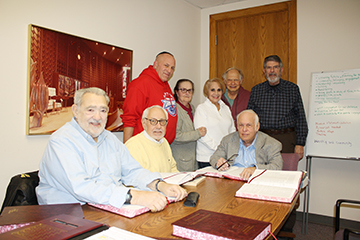
It’s been advertised as the “longest-running adult education class in the Jewish community” and it may well be. The class is Rabbi Herbert J. Mandl’s Talmud class and it’s been going strong for more than 30 years.
Rabbi Mandl, who is Kehilath Israel Synagogue’s rabbi emeritus, can’t pinpoint the exact date when the class began. He and the traditional congregation’s then-Cantor Earl Berris began teaching an adult education class soon after K.I. moved into its Overland Park building in March 1986. Within just a couple of years that class morphed into a class about Talmud.
Each week the class tackles a new subject in the Talmud, which has been defined as a collection of writings that covers the full gamut of Jewish law and tradition, compiled and edited between the third and sixth centuries. The class, held at 7 p.m. on Monday nights from the first Monday after Sukkot until the last Monday before Shavuot, is free and open to anyone in the community. It meets for about an hour.
Over the years Rabbi Mandl said attendance has ranged from six to 10 students. Some attend weekly and others “drop in.” Currently the class averages seven to eight participants a week.
“Our longest standing members both passed away in their 90s a couple of years ago,” he said. Today, some students have been in the class a long time while others are still relatively new in the class, having participated for just a couple of years.
“Over the years people will try the course and, frankly, it’s not for everybody,” Rabbi Mandl said.
“Anybody who has taken the course for more than a year and returns, stays,” he continued.
He never dreamed when he started the class it would still be around 30 years later.
“Then again I never expected to be in Kansas City more than five years, either, and look what happened,” said the rabbi who came to Kansas City in 1977 and served as the congregation’s rabbi for 35 years before retiring in 2012. He then served as interim rabbi from October 2017 until Rabbi Moshe Grussgott came on board as senior rabbi in the summer of 2018.
Rabbi Mandl explained there are two Talmuds — the Jerusalem Talmud and the Babylonia Talmud — and this class studies the Babylonian version.
“Ninety-five percent of the world studies the Babylonia Talmud because that’s where we were in exile for hundreds of years after we got booted out of Israel,” the rabbi explained.
Rabbi Mandl said the Talmud “is made up of 6,000 huge pages,” and he estimates his Talmud students have gone through “four or five books during those 30 years. He said that’s “quite a bit.”
“Sometimes we’ll only do a few sentences every week because if the topic gets involved, we sometimes don’t move very far,” he said. “We look at the commentaries and discussion starts. Sometimes we’ll do a quarter of a page, sometimes we’ll do three or four lines, it just depends what the subject is and what people bring to it.”
The topics vary widely, he said, including marriage, divorce, sexuality, ritual slaughter (which this class hasn’t covered) and “almost any topic you can imagine.”
“Those topics cover everything in life other than computers and things that didn’t exist,” he added
Because the topic is likely not the same from one week to the next, Rabbi Mandl said it’s easy for someone to jump it at any time.
“Because once you get to the next paragraph or two, you are on to a new subject,” he said.
Eunice Snitz currently has the most seniority among the participants. She began attending the class with her husband, Sheldon, of blessed memory, when it began. Another K.I member, Abbott Zolotor, has been attending the class at least 20 years as well.
“My husband and I were among the first people in the class when it started as a discussion of the parsha of the week,” Snitz said recently. “My husband passed away three years ago.”
Snitz, a longtime member of K.I., finds the class interesting.
“You learn about so much,” she said. “You start learning one paragraph and it may be something from hundreds of years ago but something about it applies to today. It’s just interesting.
Frank Loeffler, a member of Congregation BIAV, has been in the class about nine years. He agrees with Snitz.
“You can take the most esoteric topics that I’ve studied with them and take it to contemporary life,” Loeffler said.
Loeffler studies Talmud with more than one teacher and said, in his opinion, anything that’s in the Talmud is in there because it’s in dispute, not because it’s in agreement.
“Torah is law that’s in agreement,” Loeffler explained. “Talmud is issues associated with it that are in non-agreement. So in every issue we have so far there have been at least two, if not more, differing opinions, and it’s how you analyze it.”
He added that “this class is a great example in that you do have to look at things in multiple ways. That’s what keeps me coming.”
Loeffler thinks Rabbi Mandl is an excellent presenter.
“With his color commentary, while using real life circumstances, without names of course, he brings the concepts of studying a document that was sealed roughly 1,600 years ago, almost 1,700 years ago, to life,” Loeffler said.
Snitz thinks Rabbi Mandl’s teaching style is terrific.
“He has so much knowledge about so many things,” she said.
Rabbi Mandl added that every member of the class brings something different to the table and that makes for very interesting class discussions.
Why does Rabbi Mandl still teach a Talmud class? He said one reason is the group wanted him to stay on.
“I still do a little teaching, but this has become part of my life at this point,” he added.


